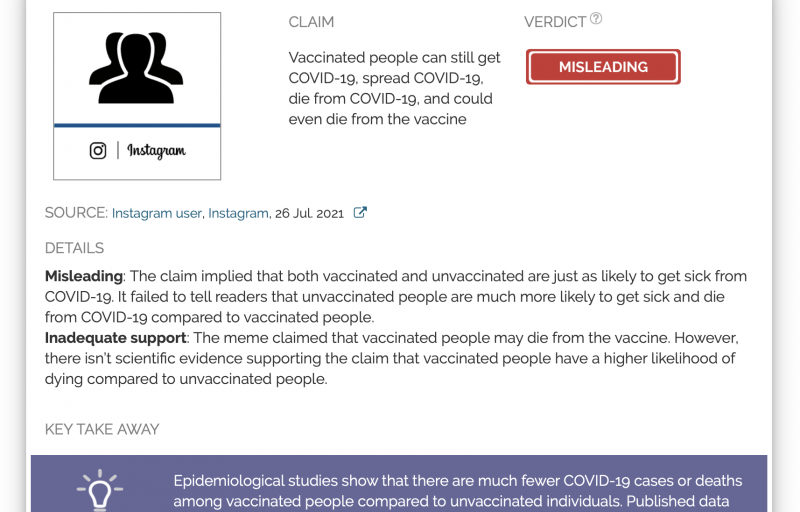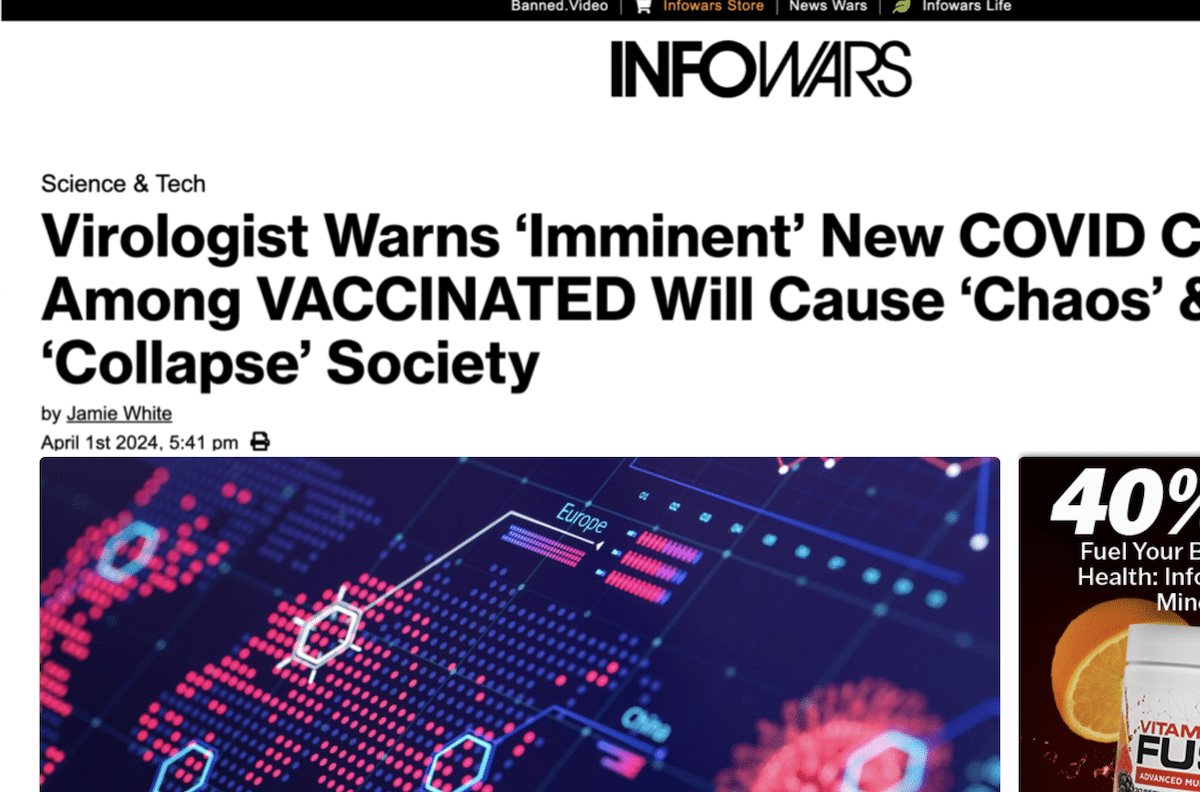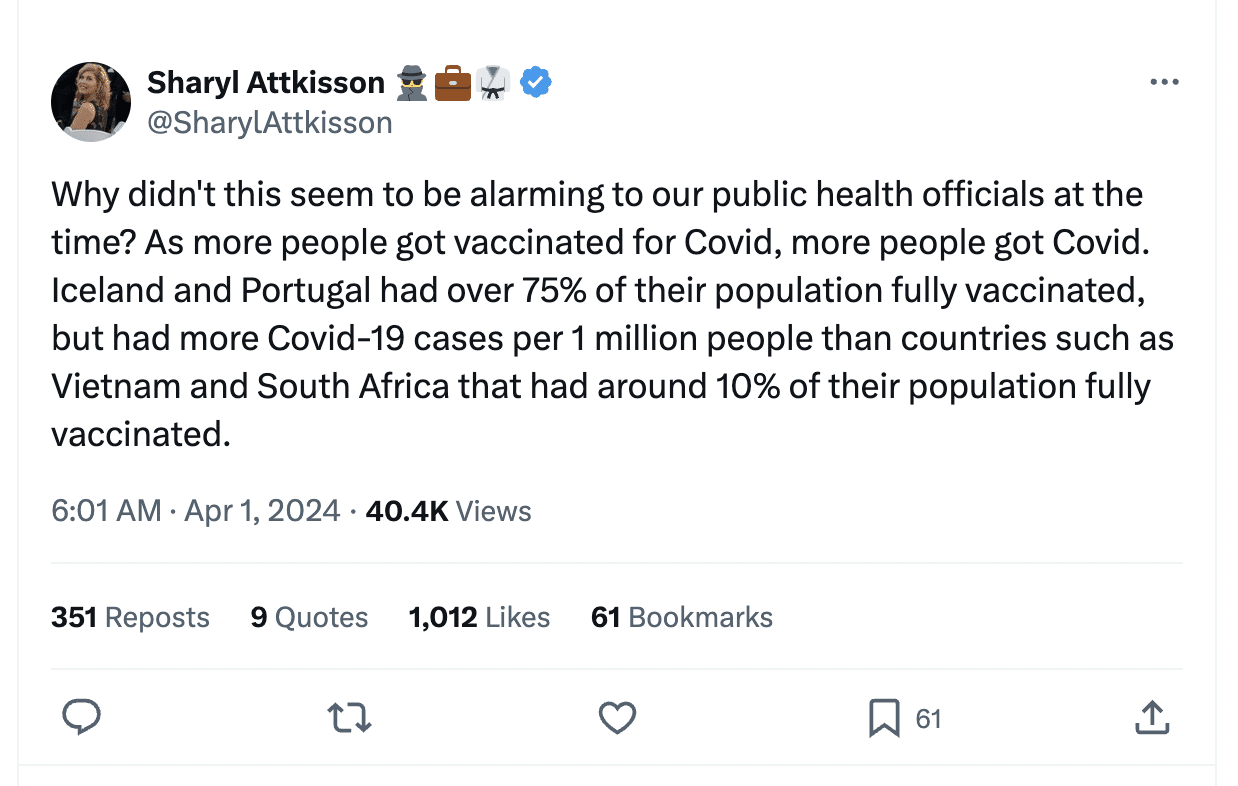- Health
Vaccinated people are much more protected from COVID-19 than unvaccinated individuals; the benefits of the COVID-19 vaccines outweigh their risks
Key takeaway
Epidemiological studies show that there are much fewer COVID-19 cases or deaths among vaccinated people compared to unvaccinated individuals. Published data show that vaccinated people infected by SARS-CoV-2 usually present a lower viral load, preventing severe forms of the disease, and reducing the likelihood of transmission. Vaccination isn’t associated with an increased likelihood of dying and efficiently protects from COVID-19.
Reviewed content

Verdict:
Claim:
Vaccinated people can still get COVID-19, spread COVID-19, die from COVID-19, and could even die from the vaccine
Verdict detail
Misleading: The claim implied that both vaccinated and unvaccinated are just as likely to get sick from COVID-19. It failed to tell readers that unvaccinated people are much more likely to get sick and die from COVID-19 compared to vaccinated people.
Inadequate support: The meme claimed that vaccinated people may die from the vaccine. However, there isn’t scientific evidence supporting the claim that vaccinated people have a higher likelihood of dying compared to unvaccinated people.
Full Claim
Vaccinated people can still get COVID-19, spread COVID-19, die from COVID-19, like unvaccinated people. But vaccinated people can potentially die from the vaccine, whereas unvaccinated people won’t run this risk.
Review
After authorizing the first COVID-19 vaccine for emergency use in late 2020, the U.S. entered a nationwide vaccination campaign. As of 28 July 2021, 49% of the population has been fully vaccinated.
Claims raising doubts about the effectiveness of COVID-19 vaccines have begun circulating on social media during this campaign. For instance, this meme published on Instagram in late July 2021 claiming that both vaccinated and unvaccinated people were at risk of getting infected by SARS-CoV-2, transmitting the disease or dying from it and that vaccinated people were additionally exposed to the risk of dying from the vaccine.
By only listing detrimental outcomes without explaining how likely these outcomes are for either group, the post misleads the reader into believing that both the vaccinated and unvaccinated individuals are equally at risk. Overall, the message is that remaining unvaccinated is safer than getting vaccinated.
Contrary to what this claim suggests, vaccines don’t need to have a 100% efficiency to be effective at fighting the pandemic. For instance, vaccines against rotavirus, a virus which causes diarrhea in children, only prevent the serious form of the disease, yet allowed a 90% reduction in the number of rotavirus-associated hospitalizations. The suggestion that vaccines would only be useful if they prevented 100% of infections is a form of the nirvana fallacy, in which reasonable solutions are rejected because they aren’t perfect, even though a perfect solution doesn’t exist in reality. Just as we wouldn’t reject a parachute before jumping from an airplane simply because parachutes don’t open 100% of the time, rejecting a vaccine because it doesn’t work at 100% effectiveness is similarly fallacious.
In order to assess whether COVID-19 vaccines present an advantage against the disease, one must ask: does vaccination lower the risk of bad outcomes from the disease, whether it is infection, transmission, severe symptoms or death?
The CDC collected the data from 37 clinical trials and real-world monitoring of vaccination campaigns. All these studies found significant effectiveness of COVID-19 vaccines in preventing SARS-CoV-2 infection, symptomatic COVID-19, and death, ranging from 64% to 99%. In fact, the majority of those studies reported an effectiveness of above 90%. Effectiveness is determined by comparing the number of COVID-19 cases, hospitalization, or deaths in vaccinated and unvaccinated groups. Thus, a 90% effectiveness indicates that vaccination reduces by 90% the number of people getting infected, sick, or dying from the disease.
Consistent with these results, an analysis of CDC data by Associated Press showed that vaccinated people account for only 1% of COVID-19 hospitalizations in the U.S. As Health Feedback already pointed out, the situation in the U.S. is not unique, as the U.K. also recorded a majority of COVID-19 hospitalization coming from unvaccinated people.
Even in the rare event where vaccinated people get infected, results indicate that they are much less contagious than unvaccinated individuals in general. Jennifer Suno, senior research fellow at the Peter Doherty Institute for Infection and Immunity, and Adam Wheatley, senior research fellow at the University of Melbourne, explained in The Conversation that large epidemiological studies carried out in England revealed that infected vaccinated individuals were half as likely to pass on the disease compared to unvaccinated persons.
Part of the reason why vaccinated people are less susceptible to severe forms of COVID-19 and less likely to infect others is that the COVID-19 vaccines significantly reduce the viral load among the few individuals who would get infected. Researchers from Israel quantified the amount of viral genetic material in infected patients and found that the amount was significantly lower among patients who had received the vaccine compared to the others[1].
Another research group ran diagnostic tests periodically among healthcare workers. Not only did they find that there were 90% fewer cases of COVID-19 among the vaccinated workers, they also found that the viral load among the few vaccinated but infected individuals was 40% lower than among the unvaccinated and infected persons[2].
Another study investigated the amount of virus between vaccinated and unvaccinated individuals among nursing home residents who were infected, and found a two-fold reduction of the amount of virus in vaccinated individuals compared to unvaccinated ones[3].
On the whole, the results from several studies demonstrate that, even though vaccinated individuals can get infected, the likelihood of infection is much lower compared to unvaccinated people. They also tend to carry lower amounts of virus, thus reducing the odds of transmitting it to others and of developing severe COVID-19.
Whether these results can be extrapolated to cases of infections by the Delta variant remains an open question, as the Washington Post revealed that internal documents of the CDC suggested a similar viral load between vaccinated and unvaccinated in the case of Delta variant infection. However, those data are still unpublished at the time of writing and a research article showed that a complete vaccination scheme elicited the production of neutralizing antibodies against the Delta variant, albeit with a lower level of antibodies[4].
Finally, the meme also claimed that the COVID-19 vaccines could kill their recipients, thus making it more dangerous for people to get vaccinated than to remain unvaccinated. It is true that the CDC established a plausible causal association between the Janssen COVID-19 vaccine and the formation of blood clots, which caused the death of three patients, as of May 2021. However, this remains an extremely rare event compared to the 13,371,560 doses of the Janssen vaccine administered. Indeed, this would equate to 2.2 deaths out of 10,000,000 injections, to be compared with the ratio of 68,000 deaths per 10,000,000 COVID-19 infection as estimated by epidemiological studies[5]. Overall, there is no evidence indicating that vaccinated people are more likely to die compared to unvaccinated people, and a person is more likely to die from COVID-19 than from the vaccine.
Contrary to popular claims, reports of deaths in the U.S. Vaccine Adverse Events Reporting System (VAERS) don’t prove that vaccines are unsafe, as Heath Feedback explained on numerous occasions. First, because anyone can submit a report to VAERS, the information in the report isn’t verified. VAERS clearly warns users relying on the database about this caveat:
“Some reports may contain information that is incomplete, inaccurate, coincidental, or unverifiable. Most reports to VAERS are voluntary, which means they are subject to biases.”
As such, VAERS data alone can’t show whether an adverse event is the consequence of vaccination. Indeed, simply because event A occurs before event B doesn’t mean that the first event caused the second. In order to establish a causal link, further investigation would be needed to determine if there is a mechanism by which event A caused event B, as explained in this Insight article by Health Feedback.
In summary, claims casting doubt over the usefulness of COVID-19 vaccines are misleading when they fail to inform the audience that vaccinated people are much less likely to get sick than unvaccinated individuals. Epidemiological studies indicate that vaccination significantly reduces the odds of getting infected, developing a severe form of the disease, and dying from COVID-19.
There is no vaccine that is 100% effective, therefore it is normal to observe some breakthrough infections among vaccinated people. But these are rare compared to cases in unvaccinated people. Furthermore, even in breakthrough infections, the viral load tends to be lower than in unvaccinated patients, thus limiting the risks of transmission and hospitalization.
REFERENCES
- 1 – Levine-Tiefenbrun et al. (2021) Initial report of decreased SARS-CoV-2 viral load after inoculation with the BNT162b2 vaccine. Nature Medicine.
- 2 – Thompson et al. (2021) Prevention and Attenuation of Covid-19 with the BNT162b2 and mRNA-1273 Vaccines. The New England Journal of Medicine.
- 3 – McEllistrem et al. (2021) Single dose of a mRNA SARS-CoV-2 vaccine is associated with lower nasopharyngeal viral load among nursing home residents with asymptomatic COVID-19. Clinical Infectious Disease.
- 4 – Planas et al. (2021) Reduced sensitivity of SARS-CoV-2 variant Delta to antibody neutralization. Nature.



